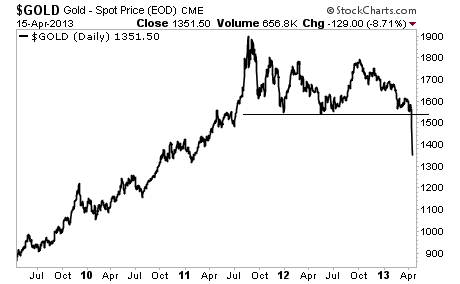SHTFplan.com
Were one restricted to watching just the paper market spots prices for precious metals, one might assume that there is major panic selling of gold and silver around the world.
A few days ago gold saw its biggest drop in thirty years, and silver was right behind it, leaving many investors concerned that gold’s decade-long run-up was nearing its end.
With all of this selling you’d think there’d be lines of panicked investors standing outside of brick and mortar local dealers and an overstock of precious metals at online retailers.
Curiously, it seems to be that exactly the opposite is happening. As the price of gold and silver collapsed to two-year lows, retailers in local markets and online have been scrambling just to keep up.
A spokesperson for JM Bullion, a major online supplier of gold and silver to the retail market, suggests that they are experiencing unprecedented demand, all the while gold and silver prices as reported by the mainstream media have been “falling” precipitously:
We still have certain things in stock, like 10 oz bars, while others, like Silver Eagles, are a bit of revolving inventory.While JM Bullion still has gold and silver in stock and is able to meet demand, investors are being advised that they may have to wait five days or more to receive their orders as the company works to clear their backlogs.
The shipments are going out as soon as inventory comes in.
Our main challenge right now is actually getting the silver into the boxes and shipped out – we have been experiencing astounding volume.
Gold is in much better shape. We have all of our 1 ounce gold coins and bars in stock.
Many other online retailers, however, are reporting significant shortages. So much so that some are being forced to cancel customer orders because there is simply no inventory, especially as it pertains to silver.
A subscriber alert from Future Money Trends indicated that the shortage is quickly becoming more widespread:
Several bullion dealers are reporting low or no inventory, others are just outright overcharging their customers. Wholesale dealers are also reporting they are out of several products including the American Eagle.Renaissance Precious Metals also reports having inventory of silver and gold available, but has advised that demand is so high, supplies are so low and paper prices are under such manipulation, customers should be prepared to pay higher premiums.
…
“…there is basically a silver shortage right now. Dealers are starting to run out of products and delay the shipping times.” David Smoler, DBS Coins
Here is a message from my good friend who works in the bullion industry when I asked him if there were real shortages happening.
“Across the board, sold out. Delivery delays up to 4-6 weeks, premium rising. Friday was our busiest day ever; until today. Which was much busier.” Andy Hoffman, Miles Franklin
This shortage of physical metals may be due in part to wholesale suppliers like CNT, the company which supplies gold blanks to the US mint, having run completely out of silver.
Two of the largest wholesale suppliers in the US, including Amark and CNT, who is the supplier of gold blanks to the US Mint for Gold Eagles, and is a registered COMEX depository, HAVE JUST SOLD OUT OF ALL PHYSICAL SILVER!!!Additionally, a major collapse of a Rio Tinto silver and copper mine in the United States last week has essentially vaporized about 16% of the physical precious metals market for potentially years to come.
Adding further pressure to the supply shortage, just a week prior to the mine collapse, the U.S. mint reported that it sold over 15 million silver eagles so far this year, leaving them so shorthanded that they have begun rationing supplies to primary dealers.
The number one driving force, however, seems to be investor demand amid what many perceive to be the next leg down in the financial crisis.
By all accounts, there is a gold and silver buying frenzy all over the world as prices have reached levels that are appealing to investors who were, as recently as last year, paying in excess of $1700 per ounce for gold and $35 per once for silver.
The shake out of ETFs and futures has left the Australian mint short of deliverables and Japanese and Chinese gold retailers seeing a “frenzied” surge in demand.Thus, despite a significant crash in precious metals prices recently, investors are not only ignoring the media hype, but they are doubling down on the historic relics in anticipation of runaway inflation and continued uncertainty in the global economy and financial markets.
The customers are not just the ‘rich’ or ‘elderly’; in China “they tend to wear water shoes and come directly from the market…;”
in Australia, “the volume of business… is way in excess of double what we did last week,… there’s been people running through the gate,” and Japanese individual investors doubled gold purchases yesterday at Tokuriki Honten, the country’s second-largest retailer of the precious metal.
 SAX
SAX






 Sgt Report
Sgt Report

